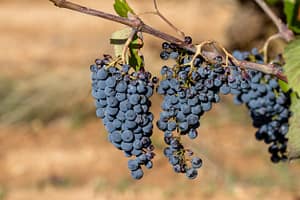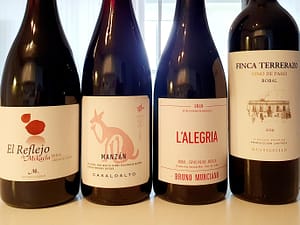I am preparing for a trip to Spain and Bobal country. Bobal is native to Utiel-Requena (where it accounts for 80% of the red grapes) and surroundings in the comunidad of València. It is also very much at home in La Mancha, such as the Cuenca and Albacete provinces. But it can be found far beyond these boundaries. It is the third most grown red grape in Spain, having lost second place recently to garnacha.
The must is normally high in colorants and tannins and is suitable both for aging and for blending with other varieties. The wines tend to be fruity, low in alcohol content and high in acidity.

I ordered four wines present in my home market. I intend to visit all of the producers, so here I will only give a short presentation of each.
Aurelio García and his wife Micaela Rubio run the first project. They have both worked and consulted in various companies locally and nationally. Here they focus on their roots, their personal taste and local grape varieties and sites.
El Reflejo de Mikaela is in a way an entry-level wine. It is fermented with 30% whole bunches in stainless steel tanks, then aged in moderately porous French vessels made from clay and silica and barrels.
Casa lo Alto is a hamlet outside Venta del Moro, València, where the winery is located. Víctor Marqués is winemaker. The wine Manzán comes from three plots planted with bobal in bush-style between 1940 and 1965. The soil is calcareous clay, poor in organic matter. Use of chemical products is avoided and biodynamic preparations are used. In the winery the grapes are destemmed but not pressed. They undergo a spontaneous fermentation with native yeasts. After pressing, it is decanted into barrels with its lees for approximately 10 months.
Bruno Murciano is a trained sommelier. In 2005 he started his project to make his own wine. He bought 8 ha of old vineyards with bobal in his hometown of Caudete de las Fuentes. In 2010 the first wine was made together with friends, and most of all his brother José Luís, who brought with him experience on how to work biodynamically, among other things.
L’Alegría is made with grapes from the Las Brunas vineyard located at 900 m above sea level. The vines are 85 years old, grown in clay soil. The wine is made in steel tanks.
Bodegas Mustiguillo of Utiel is one of the farms that have their own DO Vino de Pago. Owner Antonio Sarrión is also currently resigning after his period as president for the group Grandes Pago de España. The pago is El Terrerazo, a 160 ha property in Utiel. When Sarrión took over, and after having purchased nearby plots from local farmers, he planned to launch equal parts of bobal, tempranillo and cabernet sauvignon. But soon he realized the potential for the local grape, and bobal is now by far the leading grape in Mustiguillo’s reds.
Finca Terrerazo is a monovarietal bobal from wine from vineyards 800 meters above sea level, on very poor soils with limestone with a sandy-loam texture, from old vines planted between 1945 and 1970. Each plot was vinified separately. Fermentation in oak vats with native yeasts for 8-10 days, with gentle pump-overs and pigéage. Aged for 14 months in French oak. Bottled without stabilizing or filtering.

El Reflejo de Mikaela 2018 (Micaela Rubio & Aurelio García)
Dark red. Cherry/dark fruits, plums, herbs, sweet/warm sensation. Full, firm tannins, mature berries.
Manzán 2020 (Casa lo Alto)
Dark, blueish hint. Mature fruit, blueberry, cherry, herbs. Good acidity, dryness of strong earl grey tea, or maybe crushed stone.
L’Alegría 2019 (Bruno & J.L. Murciano)
Dark, quite dense. Mature black and red fruits (blackberry, cherry), eucalyptus, coffee. Good volume, abundant tannins, spice, quite big but also with some elegance. A couple of years of cellaring is recommended.
Finca Terrerazo 2019 (Bodega Mustiguillo)
Dark cherry. Dark and red fruits (blackberry, raspberry), spice, some toast. Good volume, firm tannins, good fruit and acidity, and a mineral touch. Bears 14,5° alcohol well. A couple of years further ageing recommended here too.
Leave a Comment




